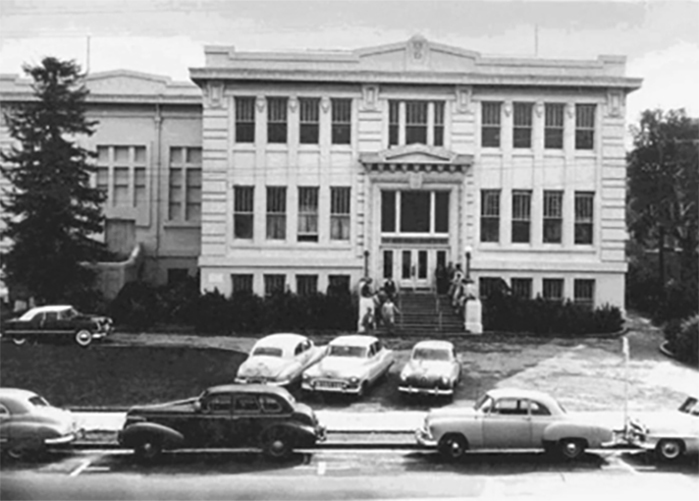Baldwin Avenue
Kodachrome movies preserve pre-World War II life at San Mateo Junior College’s first (and also third) campus
San Mateo Junior College inherited San Mateo High’s Baldwin Avenue campus after the high school moved to its present location in 1927. The Baldwin campus was actually the college’s first home, having opened in a top floor in 1922. With the return from the rickety Kohl Mansion, Baldwin also became its third.
Baldwin, too, was showing its age in 1927. Built for a younger demographic, it lacked a cafeteria, parking, a student union and many other college features. Without a lounge, students congregated (and played cards, a slightly disreputable hobby) under palm trees on the front lawn. To avoid burning the place down (the gym eventually did go up in flames in 1957), they smoked on “Nicotine Bridge,” next to the college crossing San Mateo Creek.
For a special event, students set out picnic tables on the grounds. College President Charles S. Morris and his wife Carlena attended every one.
All these activities, minus the cards and the smoking, are preserved on Kodachrome home movies from 1938-41 and now held by the San Mateo County Historical Association. Donated by alumna Mildred Stickney and digitized by the California State Library, the films show the simplicity and frugality of college life at the end of the Great Depression.
Les Williams ’39, later a World War II aviator and Stanford-trained lawyer, tap-dances in what’s probably his family’s east San Mateo back yard.
Women students have their posture checked on camera in a class called “Personal Efficiency.” This was a Progressive Era fad that covered healthy movement, study skills and time management. One student wears a mink coat – not typical of the time and place – to the shoot, and the camera keeps moving to keep her out of the frame.
Students and faculty made the best of Baldwin, as the film reveals. They maintained all the trappings of early 20th-century college life, including sports teams, a mascot, beautiful yearbooks, and frosh-soph hijinks like “The Brawl,” a muddy athletic contest in the field next to still-standing Episcopal Church of St. Matthew.
Other Baldwin features included the San Mateo County History Museum, opened in 1941 in ground-floor Room 18. History Prof. Frank Stanger and his zeal to acquaint students with primary sources shaped what eventually became one of only 174 U.S. museums accredited by the American Association of Museums.
In 1942, after America entered World War II, civil defense workers built a poison-gas contamination station and then a community canning center on Baldwin’s campus. Families brought their victory garden-grown produce to can and take home, enabling commercially grown food to be sent to soldiers.
If any of the students in the film took science or shop, they would have done so at San Mateo Junior College’s Delaware Avenue campus, then partly constructed. Only two buildings were finished before World War II and the subsequent enrollment boom that rendered Delaware obsolete.
The college continued to use Baldwin for classes including its KCSM-FM radio production program until 1955, when it was taken over by the U.S. Naval Reserve. Today, the Mills-Peninsula hospital complex occupies the site.





